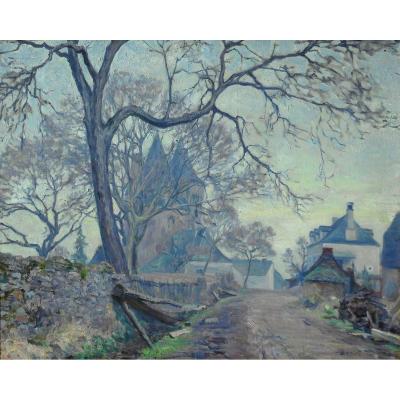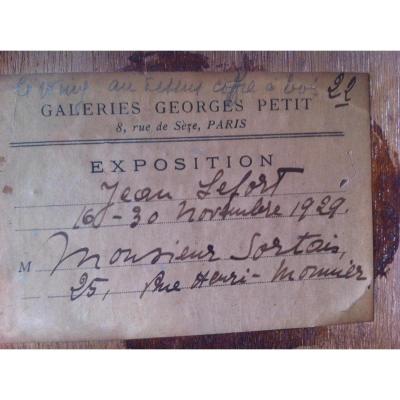"Armand Guillaumin (1841-1927) Bridge Over The Seine ~1868. Impressionist Period Crozant School"
Superb and rare pastel by Jean-Baptiste Armand Guillaumin representing a barge near a bridge on the Seine around 1868/1870 signed lower right. Pastel size alone without frame 50x65cm and 60x75cm including frame. This is indeed a magnificent pastel by Armand Guillaumin who paints here a barge near a bridge on the Seine in Paris or in its close suburbs around 1868/70, therefore in the middle of the Impressionist period or even a little before when we know that the first exhibition of the Impressionists took place in 1874 at Nadar. I found another pastel extremely close, representing the same place, smaller (29x38cm) and in a slightly different palette, which was dated, therefore 1868, which was sold on 05/16/2014 at Van Ham in Cologne for 12,000€ at the hammer (see last photo). These works therefore date from Guillaumin's real impressionist period, they are obviously the most highly rated and sought-after, because even if his works on the Creuse valley are also prized, being much later but above all much more numerous, the prices are lower than this impressionist period. Adept and undisputed master of chalk, his pastels have largely made Guillaumin's reputation; their powdery effects with in addition a subtle play of reserves and finally their richness of colors, make them real little masterpieces. Other artists such as Léon Detroy, Eugène Alluaud and especially Charles Bichet were strongly inspired by him and also tried their hand at pastel, with success, but sincerely without ever equaling the master, which is in my opinion not the case with oil paintings. I no longer present Armand Guillaumin, Impressionist painter, leader of the famous Crozant school alongside Detroy, his friends included Maurice Rollinat and Eugène Alluaud and students Henri Pailler, Julien Féron or Clémentine Ballot. He was one of the first and most faithful participants in the Impressionist group. His landscapes of the Creuse, especially those around Crozant, are among his most prized works. Originally from Moulins, Armand Guillaumin moved to Paris in 1857 to work with his uncle Besnard. He took evening classes with the sculptor Louis Denis Caillouette. In 1860, he joined the Compagnie du chemin de fer de Paris à Orléans. The following year, he met Paul Cézanne and Camille Pissarro at the Académie Suisse and participated in the Salon des Refusés of 1863. In the early 1870s, he painted in Pontoise with Pissarro. There he developed his taste for landscape painting. He executed his first etching at the home of Doctor Gachet in Auvers-sur-Oise in 1872; Guillaumin would produce seventeen of them throughout his life, as well as a few color lithographs. Joined by Cézanne, they painted on the banks of the Seine around 1873. Armand Guillaumin painted views of the banks of the Seine and more particularly views of Ivry-sur-Seine, Clamart and Charenton, as well as landscapes of Epinay-sur-Orge in the southern suburbs of Paris. These views demonstrate the artist's strong preference for water, a motif that would become one of his favorite subjects. At this time, Guillaumin was already using a palette with fairly strong tones. Armand Guillaumin was loyal to the Impressionist group. He participated in six of the eight exhibitions of Impressionist painters. He was particularly present at the First Exhibition of Impressionist Painters in 1874 and the last in 1886. A friend of Cézanne, he was also close to Van Gogh, who appreciated Guillaumin's talent as a colorist and his palette of bright colors. In 1887, he married Marie-Josephine Gareton, a teacher at the Lycée Fénelon, originally from Creuse. Edgar Degas and Paul Gauguin were his witnesses. They had four children: Madeleine in 1888, Armand in 1891, Marguerite in 1893 and André in 1896. During the 1890s, his painting became more subjective. His very expressive colours thus anticipated the Fauvists. In 1891, he won two prizes, one of 100,000 gold francs and another of 500,000, in the National Lottery, which allowed him to devote himself entirely to painting. From 1893, he regularly rented a house in Crozant where he frequented the painters of the Crozant School, in the vicinity of Fresselines, where the poet Maurice Rollinat lived. Drawing and painting from the motif, he was always drawn to water. From the banks of the Creuse, he observed the animation of the river, the bridges and the Chamil. Armand Guillaumin also made many trips to Auvergne and brought back many landscapes, in particular views of Pontgibaud, Saint-Sauves and Saint Julien des Chazes. At the beginning of the 20th century, Armand Guillaumin oriented his work towards a tighter style, a more lively, almost violent palette, which excited, from 1901, the young Othon Friesz, who declared himself dazzled by the purples, ochres and violets.
He often went to the Côte d'Azur in Agay where he produced, alongside the painter Victor-Ferdinand Bourgeois, seascapes and mountain views, of the Esterel massif and the snow-capped Alps. Armand Guillaumin then retired to the Creuse. He died on June 26, 1927 in Orly, where he was buried in the old cemetery, leaving a significant body of work from which emerged the paintings of the impressionist period, then of fauve inspiration. Today his works can be found in many museums in France and abroad, Orsay, Metropolitan Museum of Art, Petit Palais in Geneva, the Saint Hermitage in Petersburg, Limoges.... This pastel is in very good condition for its 150 years, I just point out a tiny and discreet small dent to the left of the signature. Delivered in an old frame from the 1950s which is in average condition, this pastel could deserve a more beautiful frame in my opinion. Work guaranteed authentic, I undertake to establish a certificate of authenticity, moreover if you wish you can approach the Guillaumin committee who will make you another one, obviously against flat rate payment;


















































 Le Magazine de PROANTIC
Le Magazine de PROANTIC TRÉSORS Magazine
TRÉSORS Magazine Rivista Artiquariato
Rivista Artiquariato